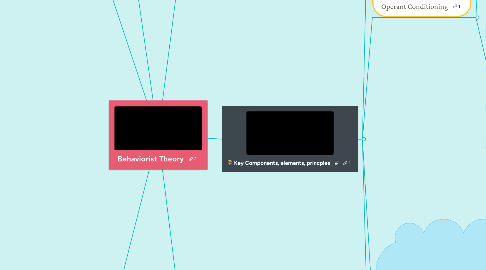
1. Basic Assumptions
1.1. What is learning?
1.1.1. Learning is a behavioral change represented by an increased response theory.
1.1.1.1. "Learning is not doing--it is changing what we do" (Skinner, 2898a, p.15 as cited in Grendler, 2009, p. 99).
1.1.2. Learning outcomes are new responses or behaviors
1.2. What is behavior?
1.2.1. Learning is behavioral change in which the behavior of the individual is the source of data. Behavioral properties must adhere to controlled conditions and physical terms.
1.3. What is the role of the environment?
1.3.1. Learning is related to changes in environment. The relationship between behavior and environment is dependent upon experimental conditions. The dynamics of an organisms relationship with the environment is identical for all species.
2. History of Theory
2.1. Disadvantages
2.1.1. Technology for complex situations is incomplete; successful analysis depends on the skill of the developer
2.1.2. Response frequency is difficult to apply to complex behaviors as a measure of probability
2.2. B.F. Skinner
2.2.1. Influences from Pavlov and Thorndikes
2.2.2. Believed psychology could only become a science through behavior study
2.2.3. Believed that theories should not be theoretical frameworks for research
2.2.4. The Teaching Machine
3. Major Classroom Implications
3.1. Positive Classroom Climate
3.1.1. Social Reinforcers: require another person, includes affection, approval, insult, and contempt (among others). Teacher must be aware of reciprocal reinforcement of socil reinforcesr.
3.1.2. Motivation: Includes interest, enthusiasm, appreciation can influence ability to learn behavior.
3.1.3. Readiness: not based on age but instead skills capacity to learn behaivor
3.1.4. Use of mastery learning: allows students to focus on learning rather than competition.
3.1.5. Punishment does not cause positive behaviors. Instead teachers can use gentle reprimands that allow the learner to modify the repose or behavior. Provide opportunities for the learner to correct instead of punishment.
3.2. Programming Instruction
3.2.1. Design sequences of stimuli-responses=reinforcements to develop sets of complex responses
3.2.2. Quick Steps to Program:1. Defin behavior to be learned. 2. Ientify learner skill set. 3. program reinfrocement schedule 4. Eventually must lead to natural reinforcement.
3.2.2.1. Scaffolding: supports for learning behavior gradually fades as need is eliminated
3.3. Learning "How to learn" skills
3.3.1. Skills based learning such as Inquiry-based learning is reliant upon trial and error
3.3.2. 1. Induce Response 2. Reinforce improvement/reinforcement 3. Allow for transfer with cues 4. Plan reinforcement schedule with goal of natural reinforcement to maintain behavior.
3.4. Problem Solving
3.4.1. In education the student can manipulate stimuli to recieve the reinforced behavior. A process of manipulation, trial, and error.
3.4.1.1. Teacher must teach skills behaviors before presenting an open-ended problem or task
3.5. Implications in Assessment
3.5.1. Multiple Choice assessment can sometimes only test recognition while writing forces students determine behavioral change in constructed responses. Students should be asked to reflect and reconstruct in their writing
3.6. Problems in Education
3.6.1. Major issue: transfer of stimulus control, timing of reinforcement, avoidance of punishment
3.6.2. The major problem of education is that students are expected to read about events or concepts instead of actually experience these learning opportunities. In the traditional school model, the classroom is an artificial setting relying on aversive control.
4. Disclaimer: This CYU map is intended for student purposes and therefore is written in summary format of a variety of sources. All sources referenced are located in the attached document.
5. Key Components, elements, princples
5.1. Experimental Analysis of Behavior
5.1.1. Elicited Responses: reflexes to a stimulus
5.1.2. Emitted Responses: behaviors unassociated with a stimulus
5.1.2.1. Experimental Analysis of Behavior: manipulation of observable events in a controlled setting
5.2. Operant Conditioning
5.2.1. Assumptions of Operant Conditioning
5.2.2. Principles of Reinforcement
5.2.2.1. Characteristics of Reinforcement
5.2.2.1.1. Reinforcement must occur immediately after the operant and is related to the behavior
5.2.2.1.2. Reinforcement is not strengthening the response but instead increasing the likelihood of the response in the future
5.2.2.2. Factors Effecting Reinforcement:
5.2.2.2.1. Skill Level: the ability of the learner
5.2.2.2.2. Reinforcement History: learners prior experiences
5.2.2.2.3. Genetic Endowment: inherited characteristics of the learner
5.2.2.3. Types of Reinforcement
5.2.2.3.1. Primary Reinforcers: stimuli that can increase the frequency of behaviors without training
5.2.2.3.2. Secondary or Conditioned Reinforcers: are associated with a primary reinforcer and another conditioned reinforcer
5.2.2.3.3. Generalized Reinforcers: social reinforcements and manipulations of physical environments
5.2.2.3.4. Positive Reinforcement: Addition of a new stimulus where the response produces a new stimulus
5.2.2.3.5. Negative Reinforcement: the removal of an object or discriminitive stimulus
5.2.2.3.6. Punishment: a removal of a positive reinforcer or the addition of a negative reinforcer
5.3. Shaping
5.3.1. Steps of a program using a schedule of reinforcement leading to the next behavioral sequence whereas a step is a reinforcing successive approximation
5.3.1.1. Types of schedule of reinforcement
5.3.1.1.1. Variable ratio schedule: frequent then declining graduated reinforcement scale
5.3.1.1.2. Negative utility: periodic reinforcement
5.3.1.2. Examples of Shaping Behavior
5.3.1.3. Contingency-governed behavior:learned behaviors are more accurate through testing in multiple contingencies and lead to other behaviors
5.3.1.4. Rule-governed behavior: advice and instruction function as verbal stimuli
5.4. Discriminative Stimuli
5.4.1. Discriminitive stimulus: stimuli that is consistently present during response reinforcement
5.4.1.1. Purpose of discriminitive stimuli:
5.4.1.1.1. Induction or stimulus generalization: when multiple stimuli acquire control over a response
5.4.1.1.2. Use by selecting discriminate stimuli to become cue for desired behavior.
5.4.2. Transfer of stimulus control: in the traditional school model, the failure of education lies in student inability to transfer waht is learned
5.4.2.1. Stimulus discrimination must come before stimulus generalization
5.4.3. To eliminate an uwanted behavior, mist develop behavior with incompatiable responsese
5.4.4. Natural Reinforces:the use of the behavior serves as the reinforcement so there is not aversive feedback. However, natural reinforcement alone is not enough with certain skills such as reading and writing.
5.4.5. Contrived Reinforces: the example of token economy. Must gradually be phased out after behavior is developed and supported with natural reinforcers.
5.4.6. timing reinforcers: supports planned ignoring, but teachers must also watch unintentionl reinforcement.
5.4.7. Extinction: decreased rate of responding to reinforcement

